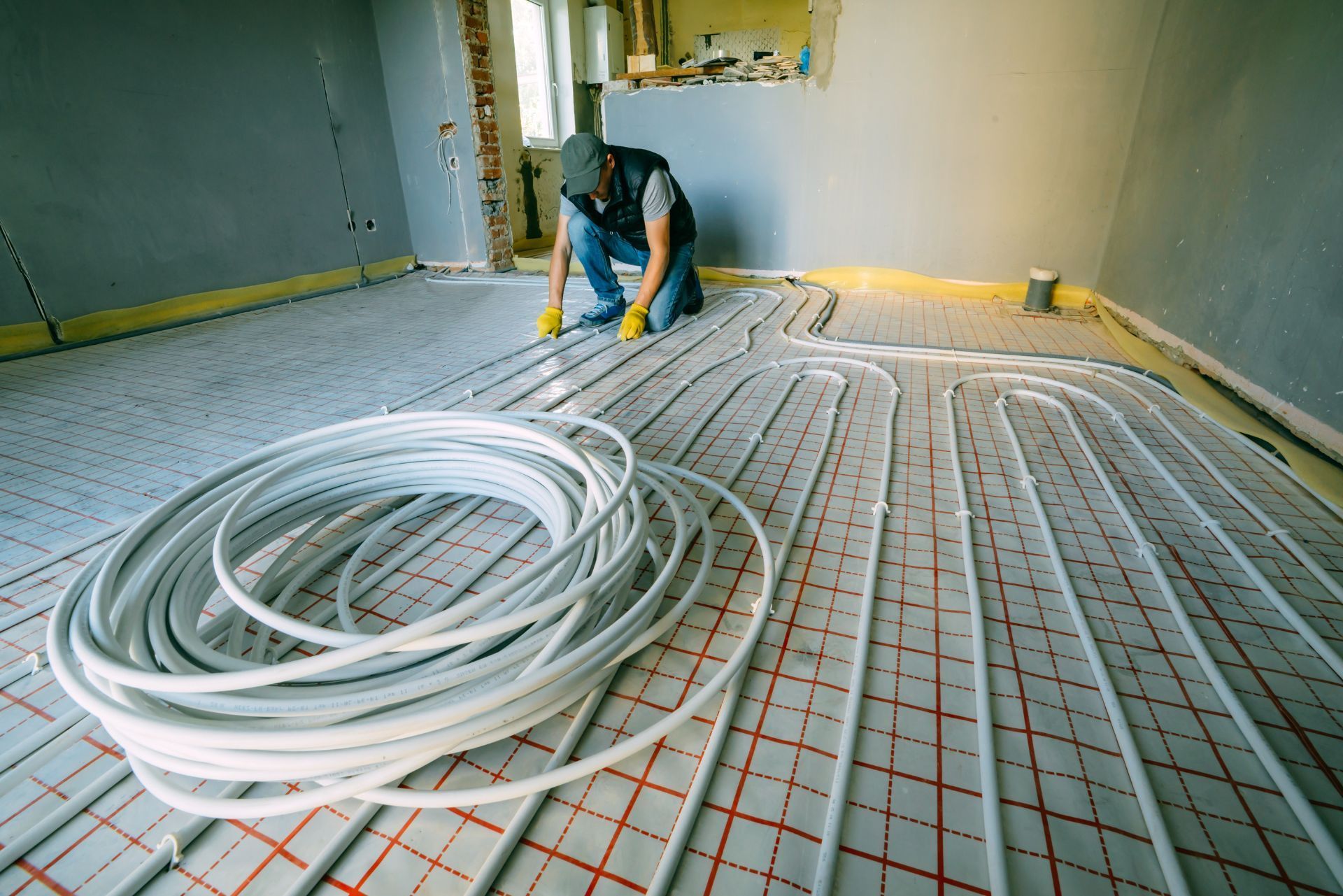Top 3 Recommended Policies

Radiant heating systems have become a cornerstone of modern heating solutions, offering energy-efficient and comfortable warmth in residential and commercial buildings. With the radiant heating industry projected to generate significant revenues and experiencing rapid growth, technicians specializing in this field face unique challenges and risks. Protecting oneself with the right insurance coverage is essential for radiant heating professionals to safeguard their business, equipment, and reputation.
In this comprehensive guide, we’ll explore everything radiant heating technicians need to know about insurance—from the types of coverage available to the factors influencing premiums. Along the way, we’ll incorporate insights from industry experts and recent market data to help technicians make informed decisions for their business protection.
As the radiant heating market continues to expand—projected to reach $1.5 billion by 2011, up from $476 million in 2004 according to Plumbing & Mechanical Magazine—understanding insurance is more important than ever.
Why Radiant Heating Technicians Need Specialized Insurance
Radiant heating installation and repair involve specialized skills and equipment that differ from traditional HVAC work. Technicians often work with complex tubing systems, electric floor heating panels, and hydronic components that require precision and care. Because of this, the risks associated with radiant heating work can vary widely.
For example, repairs can range from simple fixes costing around $90 to complex system overhauls reaching $1,500, depending on the system type and repair complexity (Angi). These variations mean that insurance policies must be tailored to cover the specific liabilities and equipment risks technicians face. The financial implications of a mishap can be significant, making it essential for technicians to have comprehensive coverage that aligns with the unpredictable nature of their work.
Moreover, radiant heating contractors often work in diverse environments—from new construction sites to retrofitting older buildings—each presenting unique hazards. Having the right insurance helps protect against property damage, bodily injury, and even professional errors that could lead to costly lawsuits. For instance, a technician might inadvertently damage a client's flooring while installing a new heating system, leading to expensive repairs and potential legal claims. Such scenarios underscore the importance of having specialized insurance that can mitigate these risks effectively.
Coverage Types Essential for Radiant Heating Technicians
Several types of insurance coverage are crucial for radiant heating professionals:
- General Liability Insurance: Covers third-party bodily injury and property damage claims arising from work activities.
- Professional Liability Insurance: Protects against claims of negligence or errors in the design or installation of radiant heating systems.
- Commercial Property Insurance: Covers damage to tools, equipment, and business property.
- Workers’ Compensation: Mandatory in most states, this covers medical expenses and lost wages if an employee is injured on the job.
- Commercial Auto Insurance: For vehicles used to transport equipment and technicians to job sites.
Choosing the right combination depends on the size of the business, number of employees, and the scope of services offered. Additionally, radiant heating technicians should consider the potential for seasonal fluctuations in work volume, which can affect their insurance needs. For example, during colder months, there may be a surge in demand for heating installations, necessitating increased coverage to handle the higher workload and associated risks. This proactive approach not only safeguards the business but also enhances the technician's reputation as a reliable and responsible service provider.

Understanding the Growing Radiant Heating Market and Its Impact on Insurance
The radiant heating industry has been experiencing remarkable growth, with a 25% annual increase over the past four years as reported by the Radiant Panel Association. This growth is driven by increasing demand for energy-efficient heating solutions and rising consumer awareness of radiant heat’s comfort benefits.
Technicians entering this expanding market should be aware that with growth comes increased competition and higher expectations from clients. As Mike Tierney of Aspen Solar Systems notes, "Radiant heating is now being specified by most contractors in our area of Colorado," highlighting how mainstream this technology has become (ACHR News).
For insurance providers, this growth translates to a need for more specialized policies that address the nuances of radiant heating systems. For technicians, it means ensuring their insurance coverage keeps pace with evolving industry standards and technological advancements.
Market Trends Affecting Insurance Needs
One notable trend is the increasing use of electric radiant floor heating, which has its own set of risks compared to hydronic systems. A detailed market report by Reports N Markets highlights how electric radiant floor heating is gaining traction in North America, influencing the types of claims insurers may see.
Additionally, the volume of radiant heating tubing installed annually is substantial. A 2002 survey found that 87% of respondents installed between 1,000 to 100,000 feet of tubing each year, indicating the scale at which technicians operate (Plumbing & Mechanical Magazine).
This scale of operation necessitates insurance policies that can accommodate large projects and the associated liability risks. Furthermore, as the market evolves, the introduction of smart technology into radiant heating systems is becoming increasingly prevalent. These systems allow for enhanced control and efficiency, but they also introduce new complexities that insurance providers must consider. For instance, the integration of IoT devices raises concerns about cybersecurity and data privacy, which could lead to additional liabilities for technicians and contractors.
Moreover, with the rise in popularity of sustainable building practices, many consumers are now looking for radiant heating solutions that not only provide comfort but also align with their environmental values. This shift is prompting manufacturers to innovate and produce more eco-friendly options, such as systems that utilize renewable energy sources. As a result, insurance policies must adapt to cover the unique risks associated with these advanced technologies, ensuring that both providers and consumers are protected in this rapidly changing landscape.

Key Insurance Considerations for Radiant Heating Technicians
When selecting insurance, radiant heating technicians should consider several factors that influence coverage needs and costs.
Scope of Services and Business Size
A technician working independently on small residential projects will have different insurance requirements than a company managing large commercial installations. Larger businesses may require higher coverage limits and additional policies such as business interruption insurance. Furthermore, technicians who specialize in specific types of radiant heating systems, such as hydronic or electric systems, may need tailored coverage that addresses the unique risks associated with those technologies. This specialization can also impact their insurance premiums, as insurers may view niche expertise as either a risk or a benefit, depending on the technician's track record and reputation.
Risk Management and Claims History
Contractors with a history of claims or working in high-risk environments may face higher premiums. Implementing strong safety protocols and maintaining excellent workmanship can help reduce insurance costs over time. Additionally, participating in regular training and certification programs can not only enhance a technician’s skills but also demonstrate a commitment to safety and quality. Insurers often reward such proactive measures with lower rates, as they indicate a lower likelihood of future claims. Keeping detailed records of safety practices and any incidents can also be beneficial during the underwriting process.
Legal and Contractual Requirements
Many clients and general contractors require proof of insurance before awarding contracts. Having comprehensive insurance coverage not only protects the technician but also enhances credibility and competitiveness in the market. This is particularly true in the construction industry, where the presence of adequate insurance can be a deciding factor for clients. Additionally, understanding the specific insurance requirements outlined in contracts can prevent potential disputes and ensure compliance with local regulations. Technicians should also consider consulting with legal professionals to navigate complex contractual obligations and ensure that their insurance policies align with their business practices.
Cost of Repairs and Liability Exposure
Given the variability in repair costs—from minor fixes to extensive system overhauls—insurance policies should cover a broad range of potential expenses. Liability coverage is especially important to protect against claims arising from installation errors or accidental damage. The financial implications of a single claim can be substantial, particularly if it involves significant property damage or personal injury. Therefore, technicians should assess their projects carefully and consider the potential costs associated with various scenarios. Moreover, understanding the nuances of different liability policies, such as general liability versus professional liability, can help technicians choose the right coverage to suit their specific needs and protect their assets effectively.
How to Choose the Right Insurance Provider
Finding an insurance provider experienced in radiant heating or HVAC industries can make a significant difference. Specialized insurers understand the unique risks and can tailor policies accordingly. They are well-versed in the nuances of the industry, from equipment failures to liability concerns, which allows them to offer coverage that truly meets the needs of contractors and technicians.
Technicians should seek providers who offer:
- Flexible coverage options
- Competitive premiums based on risk assessment
- Responsive claims handling
- Clear policy terms without hidden exclusions
Consulting with an insurance broker familiar with the radiant heating market can also help identify the best policies and discounts available. These brokers can leverage their industry connections to negotiate better terms and ensure that contractors are not left vulnerable to unexpected liabilities.
In addition to traditional coverage, consider providers that offer additional services such as risk management consultations or training programs. These services can equip technicians with the knowledge to minimize risks on the job, further enhancing their safety and operational efficiency. With the right support, contractors can focus on delivering high-quality installations and services without the constant worry of potential financial pitfalls.
Importance of Promoting Comfort and Quality
According to a 2002 survey, 72% of radiant heating contractors agreed on the importance of promoting the comfort benefits of radiant heat to increase market share (Plumbing & Mechanical Magazine). This focus on quality and customer satisfaction can reduce liability risks and claims, indirectly benefiting insurance costs. By emphasizing the energy efficiency and consistent warmth provided by radiant heating systems, contractors can not only attract more clients but also build a reputation that fosters trust and reliability.
Moreover, educating clients about the long-term benefits of radiant heating systems can lead to more informed purchasing decisions. When customers understand the value of investing in quality installations, they are more likely to appreciate the expertise of their contractors. This relationship can result in fewer disputes and claims, creating a more stable environment for both the contractor and their insurance provider. As the market for radiant heating continues to grow, those who prioritize comfort and quality will undoubtedly stand out in a competitive landscape.
Conclusion: Protecting Your Radiant Heating Business with the Right Insurance
The radiant heating industry is booming, with rapid growth and increasing demand creating exciting opportunities for technicians. However, this growth also brings heightened risks that require careful management through appropriate insurance coverage.
By understanding the types of insurance available, assessing individual business needs, and partnering with knowledgeable providers, radiant heating technicians can safeguard their livelihood and build trust with clients. Staying informed about market trends and maintaining high standards of workmanship further supports a secure and successful business.
For those interested in the latest industry insights and market forecasts, resources like Plumbing & Mechanical Magazine and the Radiant Panel Association provide valuable information to stay ahead in this dynamic field.
Contact Us
